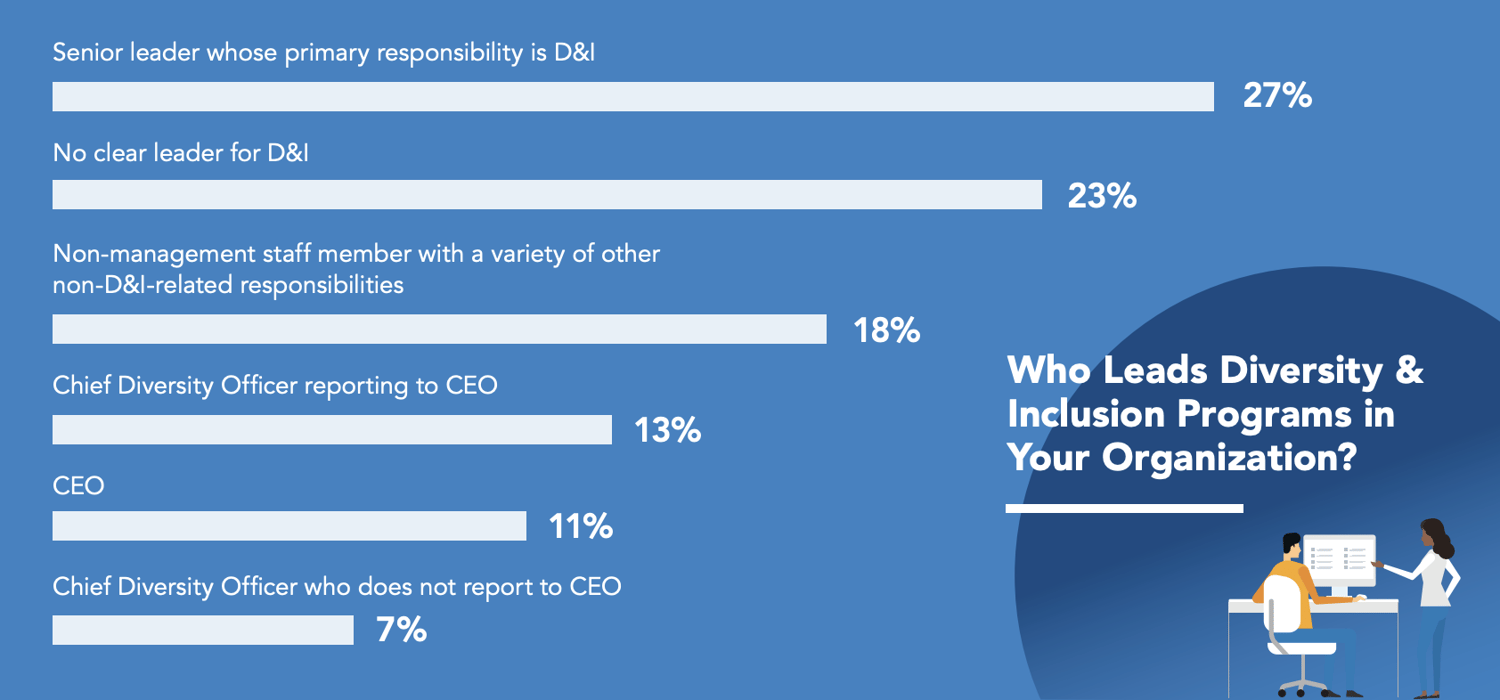15 Diversity and Inclusion Best Practices for Bridging the D&I Gap
 Diversity and inclusion efforts are an important driver of employee, team, and business success. But many organizations lack the resources, education, and leadership support to deliver on the immense potential.
Diversity and inclusion efforts are an important driver of employee, team, and business success. But many organizations lack the resources, education, and leadership support to deliver on the immense potential.
More recent events in American history have raised the stature of D&I to new heights. While there are many important people practices that could take precedent this year, D&I is one that will be unavoidable for all of us.
In this blog, we’ll share our diversity and inclusion best practices for bridging the D&I gap, including tips for:
- Building more inclusive company cultures
- Embedding diversity and inclusion throughout the organization
- Leading, manage, and fund D&I efforts to improve impact
- Developing a diverse pipeline of high-performing talent
- Measuring and taking action on diversity and inclusion
How to build a more inclusive company culture
In order for people and organizations to move towards a more inclusive culture, people first need to acknowledge the reality of unconscious bias. People should not assume that they are free and clear of it and that it only somehow affects other people. It affects us all, and the first step in limiting unconscious bias is by simply admitting that it exists.
1. Explore the unconscious biases you might have.
While it may be uncomfortable to admit, getting to know yourself better will help you improve on both a personal and professional level. Consider taking an unconscious bias or implicit bias test to help you understand the biases you have.
2. Discuss the unwritten rules that guide team performance.
Many teams set standards for how they operate. If you work on a team or in a group, you know these exist. Whether it be etiquette for sending emails or communication around vacations and paid time off. While these may seem innocent and inconsequential at first, they can have a long-term negative impact on inclusion efforts. Consider how your team:
- Conducts a meeting: Do you openly talk about life events or jump right into the agenda?
- Addresses work-life balance: Do you respect off-hours for employees or can anyone be reached at any time?
If employees’ perspectives are inconsistent about things like being available outside of business hours, it also likely means they aren’t bringing their best to the workplace each day.
3. Keep a pulse on your community, city, and country.
Staying on the sidelines is not an option for people that routinely face discriminatory and prejudicial practices. As an organizational leader, it’s important to communicate and acknowledge what is happening in the real world, even if it is not something that you, yourself, have ever faced. Staying up-to-date with current events and demonstrating a willingness to address and engage in tough conversations can help other employees know that it is OK to bring their full selves to work.
How to embed diversity and inclusion throughout the organization
Research by Brandon Hall Group found a significant difference between the percentage of organizations who say improving diversity and inclusion is important and those who demonstrate the ability to change. In order for real change to happen within an organization, there needs to be real ownership.

All too often, it seems as if D&I initiatives stay at the grassroots level, led by individual contributors. Or they get passed around between various leaders and managers with no one person or team really owning the efforts. For the tips below to stick, you need to ensure that an individual or team in your organization can dedicate paid time to these initiatives.
4. Define D&I for your organization.
While this tip may seem fairly basic, it is so often overlooked. Defining what these concepts mean to your organization can help increase buy-in from employees and get everyone on the same page. In a best-case scenario, this initial step will be completed by a diverse group of employees with representation throughout all levels of the organization.
5. Make D&I a part of onboarding and recruitment efforts.
In the same way that new employees should understand your products or service lines before starting with the organization, they should also understand your history and progress on diversity and inclusion. Embed your diversity and inclusion efforts into your company’s historical timeline and ensure new hires understand those efforts and how they are expected to contribute. If this type of information is easy to find online or recruitment boards, you can help prospective employees and boost your employer brand.
6. Incorporate D&I into your performance management practices.
Whether you manage a team of 50 or just started out in the organization as an individual contributor, there are things that we can hold people accountable for related to D&I. Make it part of your performance management process and criteria.
- For leaders and managers: This likely means ensuring decision makers are well educated in terms of progressive recruitment, promotion, and development efforts to ensure inclusive practices are followed.
- For individual contributors: They may not have decision making power when it comes to talent and promotion decisions, but you can still hold people accountable for everyday interactions. This can include using inclusive language, making team members feel welcomed, and participating in continuous education efforts.
How to lead, manage, and fund D&I efforts to improve impact
We know that diversity and inclusion efforts lead to better business outcomes related to innovation and productivity, however many still struggle to find ways to consistently prioritize these efforts. Continuous learning is critical to building a culture of D&I, but only 23% of leaders know how to manage diverse populations.
7. Designate a team dedicated to D&I.
While this may look different for organizations of varying sizes, it’s still vital for an individual or team to own your D&I efforts. This will help ensure efforts stay on track and consistent over time. Make it a priority in your organization by making sure employees earn compensation for any roles they take on—whether it be part of a full-time or part-time effort.
8. Engage with experts in your community.
It would be great if your current employee roster had all the answers for how to improve diversity and inclusion, but that is likely not the case. Leverage and engage with local experts in and around your community or line of work. With a little research, you can find valuable resources who can provide tremendous value to your organization.
9. Build continuous education into each person’s development plan.
A one-and-done training is not going to cut it. Education and training around diversity and inclusion needs to be viewed as a year-round, continuous initiative. While a full-blown D&I curriculum may be too expensive for some organizations, you can still ensure that learning occurs on a regular basis. Here are a few examples of D&I training:
- Book clubs
- Lunch and learns
- Discussions
- Community efforts
- Holiday celebrations

How to develop a diverse pipeline of high-performing talent
Recruiting a diverse workforce is critical to employers’ D&I efforts, but only 43% maintain a geographically diverse candidate pool. However, organizations that use diversity networking programs are 3.4 times more likely to report they are effective at increasing opportunities for talent mobility.

Developing a pipeline of diverse talent is not something that you will likely achieve overnight. It will take dedication, effort, and buy-in from all levels of the organization. However, there are steps that all levels of the organization can take in order to see improvement.
10. Do your research.
Within your community and your industry, investigate the organizations and partnerships out there that promote the inclusion of underrepresented populations in the workplace. Don’t rely on informal networks anymore to fill open positions and expand the use of current job boards. There are numerous job boards out there focused on finding talent from all backgrounds.
11. Encourage managers to expand their network.
This doesn’t mean just adding anyone as a connection on LinkedIn. Managers and leaders can (and should) be intentional with ways they expand their network. Consider covering the cost for each manager to join one local professional development group or chapter in their field. While this may not immediately expose them to a diverse set of job candidates, it will allow them to continue to expand their network in unique ways.
12. Develop mentorship and sponsorship programs.
While many employees may seek out a mentor on their own, not all employees will see that as an option for themselves—or not know how to start that relationship. Both mentorship and sponsorship programs can be beneficial for employees and organizations. Your aim should be to design a program that is geared towards advancing traditionally underrepresented groups.
How to measure, understand, and take action on diversity and inclusion efforts
Like any good initiative, it’s only as valuable as the metrics you are measuring. Committing to being more intentional towards D&I as a company is great. But if that commitment only consists of a few public statements throughout the year then it will fall short.
13. Create goals that each level of employee can contribute to.
If your goal is to increase representation on your leadership team or board of directors, a new hire at the individual contributor level may feel a lack of ownership for the goal. Don’t just set goals at the leadership level. Ensure employees throughout the organization have something they can work towards as well.
14. Share goals and progress with prospective new hires.
Let candidates know what your organization is working towards and the progress that’s been made. This can help signal your intentions to potential new employees and also invites them to contribute to the efforts as well.
15. Focus on short-term and long-term goals.
Set goals that benefit both the current state of your company and the future state of the community you work in. For every dollar that you contribute to internal and current efforts to boost D&I in your organization, pledge that same amount towards building for the future. Invest in educational opportunities in your community, support job programs aimed at underrepresented communities, and diversify your talent pipeline.
Diversity and inclusion initiatives are continuous and always evolving. For more ways to improve your efforts and best practices to bridge the D&I gap in your organization, download our ebook Diversity and Inclusion in the Workplace.



![[Infographic] Bridging the Diversity and Inclusion Gap: Research from Brandon Hall Group >>>](https://no-cache.hubspot.com/cta/default/99128/b86d38a4-79fb-4882-adda-59229a93c491.png)



